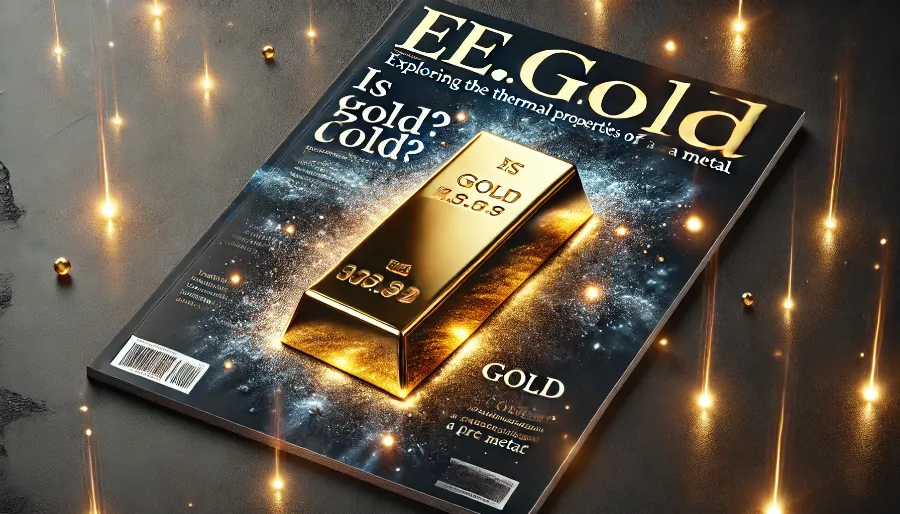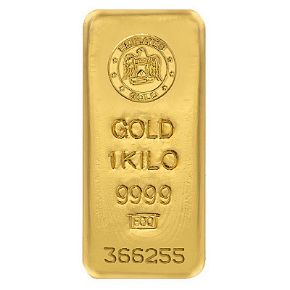
Why Gold Feels Cold to the Touch
Gold often feels cold when touched because it is an excellent conductor of heat. When you place your hand on a gold object, the heat from your skin transfers quickly to the metal, creating the sensation of coolness. This rapid heat transfer is a result of gold’s high thermal conductivity, a property that makes it invaluable in various industries beyond jewelry and investment.
What Makes Gold a Thermal Conductor
Gold is one of the most thermally conductive metals, ranking just below silver and copper. Its atomic structure allows electrons to move freely, enabling efficient heat transfer. This property is why gold is used in high-tech applications such as electronics and aerospace, where efficient heat dissipation is crucial.
Who Benefits from Gold’s Thermal Properties
The unique thermal characteristics of gold are beneficial to:
Engineers: Gold’s conductivity is leveraged in precision components like circuit boards.
Investors: Understanding gold’s properties can add depth to investment decisions.
Designers: Gold’s ability to stay cool makes it a comfortable material for high-end jewelry.
Where Gold’s Thermal Properties Are Applied
Gold’s ability to manage heat makes it indispensable in various fields:
Electronics: Gold is used in connectors, switches, and microchips to enhance performance and durability.
Medical Devices: Its non-reactive and conductive properties make gold ideal for use in sensitive equipment.
Aerospace: Gold is employed in spacecraft to reflect heat and regulate temperature.
When Does Gold Feel Warm Instead of Cold?
Gold can feel warm when it has absorbed heat from its surroundings. For example, if gold jewelry is left in direct sunlight or near a heat source, it will warm up and lose its cold sensation. However, gold’s high conductivity allows it to equalize with ambient temperatures quickly.
How Gold’s Thermal Properties Impact Everyday Use
Comfortable Jewelry: Gold’s quick temperature regulation makes it a preferred material for jewelry, ensuring it adapts to body heat.
Safe and Reliable Electronics: Its thermal conductivity prevents overheating in electronic devices.
Decorative Features: Gold’s ability to dissipate heat evenly is beneficial for intricate designs and coatings.
Why Gold’s Thermal Conductivity Matters
Gold’s thermal properties go beyond sensation; they are a cornerstone of its functionality in high-performance settings. Its ability to transfer heat efficiently reduces energy waste, enhances durability, and ensures safety in critical applications.
Debunking Myths About Gold and Temperature
Myth 1: Gold is Always Cold: While gold feels cool initially, it adapts to surrounding temperatures quickly.
Myth 2: Gold Retains Cold Longer: Gold doesn’t retain cold longer than other metals; it simply transfers heat more efficiently, creating the sensation of coolness.
Myth 3: Gold’s Conductivity is Only for Electronics: Gold’s thermal properties also play a role in jewelry, art, and even industrial applications.
Combining Gold’s Aesthetic and Functional Benefits
Gold’s unique blend of beauty and thermal efficiency makes it a versatile material. It is not only a symbol of luxury but also a practical choice for industries requiring high performance and reliability.
How to Test Gold’s Thermal Conductivity at Home
You can experience gold’s thermal properties with a simple test:
Step 1: Place a gold item in a cool environment, such as a refrigerator, for a few minutes.
Step 2: Touch the item and observe how quickly it feels cold.
Step 3: Hold the item in your hand to feel how quickly it adapts to your body temperature.
Gold’s Role in Sustainable Technologies
As industries seek sustainable materials, gold’s ability to conduct heat efficiently makes it a key player in energy-saving technologies. From solar panels to advanced cooling systems, gold contributes to innovative solutions for a greener future.
Frequently Asked Questions About Gold and Temperature
Why does gold feel cold? Gold feels cold because it conducts heat efficiently, quickly drawing heat away from your skin.
Does gold stay cold longer than other metals? No, gold’s high thermal conductivity means it equalizes with surrounding temperatures quickly.
Can gold feel warm? Yes, gold can feel warm if it has absorbed heat from its environment.
Why is gold used in electronics? Gold’s thermal and electrical conductivity make it ideal for reliable, heat-resistant components.
Is gold the best heat conductor? Gold is highly conductive but ranks below silver and copper in thermal conductivity.
Does gold’s conductivity affect its use in jewelry? Yes, gold’s quick temperature regulation makes it comfortable for everyday wear.
How does gold compare to silver in conductivity? Silver is slightly more conductive than gold but less resistant to corrosion, giving gold an edge in certain applications.
Can gold’s temperature be dangerous? Gold itself is not dangerous, but in extreme environments, its thermal properties can transfer heat quickly, requiring caution.
How is gold used in heat regulation? Gold reflects and dissipates heat in applications like spacecraft and medical devices.
Does gold retain cold? Gold doesn’t retain cold; it transfers heat efficiently, creating a temporary sensation of coolness.
How Gold’s Thermal Properties Influence Its Value
Gold’s unique ability to efficiently conduct heat and electricity is a significant factor in its widespread applications and enduring value. Beyond its role as a precious metal for investment and jewelry, gold's thermal properties make it indispensable in industries that demand high performance and reliability. This functional aspect adds another layer of intrinsic value to gold, reinforcing its status as one of the most versatile materials on Earth.
Gold in Everyday Applications
Gold’s thermal conductivity is utilized in ways that impact our daily lives.
Smartphones and Electronics: Gold connectors ensure efficient heat transfer and reliable performance in devices we use daily.
Luxury Watches: Gold is a popular choice for high-end timepieces due to its ability to regulate temperature and maintain comfort during wear.
Architectural Applications: Thin gold coatings on glass reflect sunlight, helping to maintain indoor temperatures in an energy-efficient manner.
Why Gold is Preferred Over Other Metals
Although metals like silver and copper are more thermally conductive than gold, they lack some of gold's critical advantages:
Corrosion Resistance: Gold doesn’t tarnish or oxidize, ensuring durability in extreme conditions.
Malleability: Gold can be easily shaped or coated, making it ideal for intricate designs and applications.
Aesthetic Appeal: Gold’s natural luster adds a luxurious touch that other metals cannot replicate.
The Role of Gold in Extreme Environments
Gold’s ability to withstand high temperatures and corrosive environments makes it indispensable in aerospace and industrial applications. For instance, gold is used to coat components of spacecraft, where its heat-reflective properties protect against the intense temperatures of space.
How to Identify Authentic Gold Using Thermal Properties
One unique way to identify real gold is by observing its response to heat:
Step 1: Heat the gold item gently with a flame or by holding it in a warm environment.
Step 2: Observe any changes in color or surface. Real gold will not tarnish or discolor, unlike fake gold or gold-plated items.
Step 3: Handle the item to feel how quickly it adapts to your body temperature.
Gold’s Historical Significance and Thermal Properties
Gold’s use throughout history wasn’t limited to its beauty. Ancient civilizations recognized its resistance to tarnish and its ability to adapt to various environments. From reflective coatings in ancient Egyptian temples to functional uses in modern technology, gold’s thermal properties have consistently made it a material of choice.
Sustainability and Gold’s Thermal Efficiency
Gold plays a critical role in sustainable technologies, particularly in renewable energy systems.
Solar Panels: Gold is used to enhance the efficiency of photovoltaic cells, helping to convert sunlight into energy.
Energy Storage: In advanced battery technologies, gold helps in maintaining consistent thermal conditions.
Cooling Systems: Gold’s heat dissipation properties improve the efficiency of cooling mechanisms in green technologies.
Combining Gold’s Luxury with Practicality
Gold’s dual role as a luxurious and practical material continues to set it apart from other precious metals. Its ability to enhance both aesthetic and functional applications ensures its relevance in industries ranging from fashion to technology.
How Gold’s Thermal Properties Make It Unique
While many metals conduct heat, gold’s combination of thermal efficiency, resistance to corrosion, and ease of manipulation makes it unparalleled. This unique combination has allowed gold to remain at the forefront of innovation for centuries.
Gold’s thermal properties make it a fascinating material, blending luxury with functionality. Whether you’re wearing gold jewelry, investing in gold bars, or using it in high-tech applications, its ability to conduct heat efficiently is a defining characteristic. Explore the many ways gold enhances comfort, performance, and sustainability, proving its value as more than just a precious metal.
NOTE
This Content is the copyrighted content of EE.GOLD. All rights are reserved. You are welcome to share or use our content only by including direct links to our website. Any other form of reproduction, distribution, or use without proper attribution is strictly prohibited.
This Content is intended solely for educational purposes. The information provided does not constitute financial or investment advice.
Please note that Digital Storage Receipt, Secure Storage Solutions, and Physical Gold Sales are the only services offered by EE.GOLD.
We strictly adhere to government regulations and are firmly against all illegal financial or investment activities globally.
For further inquiries, feel free to contact us through our official channels.










.png)

